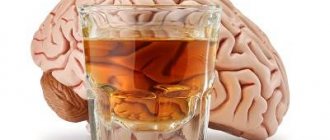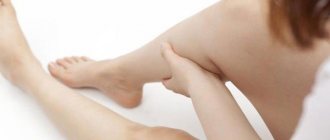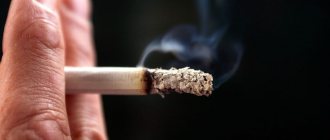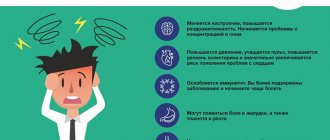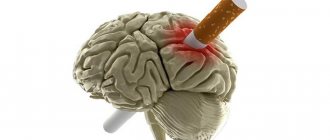All people facing this problem should know how to clean the vessels of the head and neck. Until recently, atherosclerosis was considered a pathology that affected only older people. Years passed and the situation changed. The disease is not only becoming more common, but also affects young people.
The issues of its therapy are becoming more and more relevant, not only for patients, but also for scientists. It is especially important to know how the vessels of the head and neck are cleaned. We will look at how to remove deposits and which methods are best for this below.
Example of an artery that needs cleaning
Compound
Cytoflavin contains in 1 ml of solution:
- riboflavin mononucleotide - 2 mg (vitamin B2);
- nicotinamide - 10 mg (vitamin PP);
- inosine - 20 mg (riboxin);
- succinic acid - 100 mg.
The composition also includes water for injection and other additional components: N-methylglucamine, sodium hydroxide.
Medicines for the prevention of atherosclerosis
How to reduce blood levels? There are medications that help do this:
These drugs reduce the production of an enzyme that is needed to make cholesterol in the body. They also increase the concentration of apolipoproteins, which transport cholesterol to the liver.
- Bile acid sequestrants
They bind cholesterol and the acids that are formed from it in liver tissue. In this case, the liver believes that there is not enough bile acids and synthesizes them in additional quantities, using cholesterol for this. Thus, further reducing its concentration in the body.
They reduce the concentration of triglycerides in the blood and, acting together with statins, remove cholesterol from the body.
These medications, especially bile acid sequestrants and fibrates, have side effects. They are prescribed only at a certain stage of development of atherosclerosis, and only a doctor should do this, taking into account the long list of contraindications. Taking these medications on your own is dangerous.
Pharmacological properties
When ingested, Cytoflavin has a neurometabolic effect. The effect of a medicine on human health is determined by the properties of the substances included in its composition.
Succinic acid acts as a metabolite in the Krebs cycle. It helps increase the production of ATP molecules. They ensure accelerated passage of those biochemical reactions and processes that require energy. Under its influence, the process of oxygen utilization in cells improves.
Inosine is a precursor to ATP. Its entry into the body from the outside makes it possible to increase the production of ATP due to the production of molecules from the finished substrate. Under the influence of nicotinamide and riboflavin, the reactions of the Krebs cycle are activated.
The medicine is intended for:
- activation of cellular metabolism;
- increasing the resistance of the membranes of auxiliary cells and neurons to the effects of ischemia;
- restoration of consciousness;
- stimulation of blood flow (cerebral and coronary);
- normalization of neurological status;
- activation of metabolic processes in the central nervous system;
- improving brain activity (increasing productivity of thinking, improving memory, attention);
- reducing symptoms of emotional disorders (relieving depression, reducing anxiety).
Cytoflavin promotes awakening after anesthesia if the patient remains depressed after the drugs were administered. If you start administering it after a stroke within 12 hours, the lesions are reduced, the condition is gradually restored, and the likelihood of disability in the future is reduced.
Thanks to the combined effect, Cytoflavin improves respiration at the tissue level and increases the energy supply of cells. Under the influence of the drug, oxygen starvation of cells is eliminated. The product improves blood supply to damaged areas and neutralizes free radicals.
Can you get a headache after IV drips?
Magnesia for pressure surges is an effective drug that provides rapid vasodilating results.
Blood pressure often rises sharply under the influence of negative emotions, weather conditions, illnesses, during pregnancy, and during menopause.
The painful condition is characterized by: dizziness, periodic headaches, noise and whistling in the ears, rapid heartbeat, nausea. An overdose of magnesium causes apathy, breathing problems, and drowsiness.
Search data for your request:
Wait for the search to complete in all databases. Upon completion, a link will appear to access the found materials.
WATCH THE VIDEO ON THE TOPIC: Headache, treatment. I have a headache, what should I do?
Why do you feel dizzy after an IV?
Undoubtedly, removing alcoholics from binge drinking is a difficult task and often requires medical assistance.
Quite often, men and women have to be hospitalized because self-treatment does not have the desired effect.
A person can be sobered up at home, but withdrawal symptoms can be stopped and all the negative consequences of binge drinking can be eliminated only in a specialized institution with the help of qualified doctors.
If relatives nevertheless decide to treat an alcoholic at home, they should consult a narcologist. It is best to call a doctor at home. He will examine the person and prescribe the necessary medications. Proper treatment helps cleanse the body of toxins and harmful metabolites of ethyl alcohol, relieve intoxication, and improve the functioning of all organs and systems.
Symptomatic therapy helps alleviate the suffering of alcoholics. Today, you can find many drugs in the pharmacy that will relieve nausea, sweating, headaches, fear, weakness and other consequences of long-term alcohol consumption.
Long-term alcohol intoxication has an extremely negative impact on the health of both men and women. In some cases, the consequences of binge drinking are so severe that they lead to death.
Almost all people after binge drinking experience a pronounced electrolyte imbalance, a decrease in the body’s nonspecific resistance, and severe dysbacteriosis. Naturally, all this affects the functioning of absolutely all organs and systems.
Alcoholics have impaired liver function, digestion and absorption of nutrients, decreased immunity and deteriorated general health.
Long-term binge drinking is accompanied by the development of severe dysfunction of the nervous system. Men and women develop depression, unreasonable fear and panic, pain and dizziness.
Many people cannot sleep, and during restless sleep they have nightmares. All this is only an external manifestation of deep organic brain damage. Naturally, the reasons lie in the long-term toxic effects of alcohol.
Alcoholics may also develop a fever and excessive sweating.
Each person's body recovers over a different period of time. The duration of rehabilitation depends on the age and gender of the person, the functional state of the liver, the duration of the binge, the amount of alcohol consumed and many other factors.
As a rule, men recover slightly faster than women. As you know, alcohol metabolism occurs in the liver. The enzyme systems of this organ ensure the breakdown of ethanol and its complete utilization. The resulting metabolites are excreted by the kidneys.
A healthy liver processes 7 mg of ethyl alcohol in one hour. Knowing the amount of alcohol consumed in terms of pure alcohol, you can find out how long it will take to completely cleanse the body.
Detoxification therapy greatly speeds up this process. It should be noted that to fully recover from a long-term binge, it is not enough to cleanse the blood and tissues of toxins.
It is necessary to restore the normal functioning of the nervous, digestive, cardiovascular, genitourinary and other systems of the body.
Symptomatic treatment is also important - it helps to make the alcoholic feel better.
How long it will take to completely eliminate the negative consequences of binge drinking also depends on the quality of medical care provided. Naturally, inpatient treatment or calling a narcologist to your home will be more effective than independent attempts to resuscitate a drinker.
Therefore, it is best to place an alcoholic in a clinic or drug treatment center, since it is extremely difficult to restore the body after heavy drinking on your own. Typically, withdrawal symptoms last from three to six days. In case of severe intoxication, it can last up to two weeks.
After this, there is a noticeable improvement in well-being, but psychosomatic disorders may make themselves felt for several more months. Adequate treatment helps to get rid of them much faster.
It's no secret that stopping alcoholics is one of the most important points in getting out of binge drinking. Droppers help to quickly relieve intoxication and almost immediately alleviate a person’s condition.
Often, relatives dig out an alcoholic at home by calling a narcologist or simply listening to the advice of friends. The last option is quite risky and does not always help get rid of binge drinking.
The solution for infusion should be selected by a specialist, since its composition will differ in each specific case. A properly placed drip helps reduce the risk of relapse into binge drinking.
The fact is that cleansing the body reduces the need to drink alcohol.
The person’s well-being improves and the desire to seek another dose of alcohol disappears.
Immediately after sobering up, a person should drink milk or chicken broth; a little later, they will need to include more herbal teas and natural juices in their diet. It would be appropriate to add natural honey to tea.
The menu must include milk and fermented milk products - cottage cheese and kefir. Since they have the ability to neutralize harmful metabolites, they will perfectly help relieve intoxication.
You should eat porridge, soups and broths every day. Fresh fruits and vegetables will help restore your health. A good drinking regime and consumption of foods that are natural diuretics will help restore health.
Watermelons, cucumbers, lingonberries, and green tea will be beneficial. You should also eat more asparagus, parsley, and dill - they not only have a diuretic effect, but also greatly promote detoxification. To return to a normal lifestyle, it is not enough for a person to stop drinking. To avoid the development of severe complications, proper recovery of the body after binge drinking is necessary.
First of all, you should take care of the heart, liver, kidneys, and nervous system. Correction of electrolyte imbalance and dysbacteriosis and symptomatic treatment are of no small importance.
Very often, men and women experience rapid heartbeat and greatly increased blood pressure after heavy drinking. Some people experience various arrhythmias caused by a lack of certain electrolytes.
Naturally, each disorder must be corrected by prescribing certain medications.
Source: //indosti.ru/mogut-li-bolet-golova-posle-kapelnic/
Indications and contraindications for use
Adults are prescribed Cytoflavin in combination therapy in parallel with the use of other drugs. Treatment is necessary for patients who have:
- damage to the vascular system responsible for feeding the brain;
- acute disturbance of the blood circulation process in the brain;
- encephalopathy that occurs after anesthesia, as a result of a long process of poisoning or endotoxicosis;
- encephalopathy resulting from hypoxia in patients who underwent cardiac surgery using an artificial heart system.
Cytoflavin is used to prevent the development of encephalopathy before cardiac surgery.
Cytoflavin is prescribed to newborns for cerebral ischemia resulting from oxygen starvation of the brain. It is used as part of complex therapy. The drug is even used to treat premature babies born at 28-36 weeks of pregnancy.
Contraindications for use include individual intolerance to the medication. The drug is not prescribed:
- pregnant and lactating women;
- people in critical condition (an exception is made for newborns).
Adults whose condition is assessed as critical are not given the drug intravenously until their hemodynamic parameters are normalized.
Juice treatment
Treatment with juices is effective, but long-lasting. In addition to eliminating plaques on the vessels, all toxins will be removed from the body.
The following can be applied:
- Birch sap - taking it regularly helps cleanse the circulatory system in the body. It is enough to drink three glasses a day.
- Beetroot juice. Drinking it in its pure form can be unpleasant, so mixing it with honey or carrot juice is allowed. The cleansing properties are strong, so dilute the juice with a small amount of water before drinking.
- Apple or pomegranate juice has a beneficial effect on the entire body.
The photo below is an example of products recommended for cleaning
All of these foods are important for central nervous system health.
Recipes for cleansing the blood vessels of the brain from cholesterol deposits are varied. There are no special contraindications to the use of folk remedies. However, you need to remember that some products can provoke the development of allergies, so consult your doctor before using them.
Directions for use and dosage
Cytoflavin in ampoules is intended for slow intravenous administration; injections into a vein or muscle with this drug cannot be given. To create a solution, the medicine is diluted in a ratio of 1:10 or 1:20 with sodium chloride 0.9% or D-glucose 5-10%.
For adults
Patients who have impaired cerebral circulation should begin administering the drug immediately after the first signs of pathology or diagnosis are made. Prescribe 10 ml of Cytoflavin, the recommended interval between droppers is 8-12 hours. The approximate duration of the therapeutic course is 10 days. For patients with a complicated form of pathology, the single dose is increased to 20 ml.
People suffering from the consequences of cerebrovascular pathologies are administered 10 ml of Cytoflavin once a day, treatment lasts 10 days.
For patients with encephalopathy that has developed due to hypoxia or toxic damage, drip infusions are indicated. You should pour 10 ml of the product per dropper, taking a break of 8-12 hours between procedures. The duration of treatment is 5 days.
For patients in a coma, infusions of 200 ml of D-glucose with the addition of 2 ampoules of Cytoflavin are recommended. For people with post-anesthesia depression, the medicine is prescribed in a similar dosage once.
To prevent the development of encephalopathy due to hypoxia in patients who are planning to undergo cardiac surgery with the connection of an artificial circulatory system, it is recommended to administer 20 ml of Cytoflavin. The specified amount of medication is diluted in 200 ml of 5% Dextrose. The infusion is not done daily. The following therapeutic regimen is recommended: 3 days before surgery, immediately before surgery, or 3 days after it.
For children
The dosage of Cytoflavin in newborn patients with diagnosed cerebral ischemia is selected individually. They are recommended to administer 2 ml/kg per day. Cytoflavin is diluted in a D-glucose solution with a concentration of 5 or 10%.
If indicated, the medicine is prescribed to newborns immediately after birth; the first dropper should be placed in the first 12 hours. The optimal period for starting infusion therapy is 2 hours from the moment of birth. Newborns are recommended to administer the medicine with an infusion pump. It can deliver it at a rate of 1 to 5 ml/hour. The speed is selected by the doctor depending on:
- child's weight;
- planned daily volume of solution for therapy;
- hemodynamic parameters.
Using an infusion pump ensures a uniform flow of medication into the body. The recommended course of treatment is 5 days, but its duration may be changed by your doctor.
Overdose and possible side effects
Due to the fact that the drug is administered in hospitals by drip, the likelihood of an overdose is minimal. Such cases are unknown in the history of medicine. In case of overdose, symptomatic therapy is recommended.
During treatment with Cytoflavin, complications often appear when the drug is infused too quickly. Patients may experience redness of the skin or sensations of heat or warmth in the body. These conditions may be accompanied by bitterness or dry mouth. With such symptoms, there is no need to interrupt therapy; it is enough to reduce the infusion rate.
A number of patients experience allergic reactions while undergoing Cytoflavin therapy. They may experience the following signs of intolerance:
- skin itching;
- an increase in urea concentration, which is reflected in the results of blood tests;
- hypoglycemia;
- attacks of gout.
Rare complications include:
- feeling of discomfort and pain in the epigastrium, chest;
- tingling sensation in the nose;
- nausea;
- breathing problems;
- headaches, dizziness;
- pale skin;
- impairment of odor perception.
Newborns are at risk of acid-base imbalance.
How to eliminate unfavorable factors?
Factors that provoke blockage of blood vessels include the following:
- The patient leads a sedentary lifestyle and does not play sports.
- Poor nutrition, insufficient amounts of nutrients and vitamins. As a result, many unpleasant diseases can arise. Abuse of junk food can also be included here.
- Excess body weight.
- The development of a disease such as diabetes.
- Frequent stress, depression.
- Abuse of bad habits: smoking, drugs, alcohol.
- Frequent high blood pressure.
All the factors listed above can and should be controlled, which is why they are called modified. There are others that are not modified - they cannot be controlled.
This can include the patient’s age, gender, hereditary predisposition, etc. People belonging to the second category need to especially carefully monitor their health.
An example of how the lumen of an artery narrows in the presence of plaques
Pay special attention to physical activity. Clogged blood vessels prevent you from fully bending and turning your head. In this case, you can do gymnastics, but all this should be monitored by the attending physician.
Proper nutrition
What products cleanse cerebral vessels? Up to 30% of cholesterol enters the human body with food. Diet is an important condition in the treatment of atherosclerosis, in addition, it is also a good preventive measure (see Foods that are good for the heart and blood vessels: what to eat to keep our “engine” healthy for many years).
Interesting! In numerous studies, scientists have proven that a proper diet helps reduce the level of atherogenic lipids by about 10%.
First, patients should refuse or reduce their consumption of foods of animal and fatty origin: sour cream, lard, butter.
Poor diet contributes to the appearance of plaques
In addition to all this, it is not advisable to often eat cottage cheese, especially if it is fatty, egg yolks, or caviar. All this negatively affects your health.
Important! In order to compensate for the lack of animal products, you need to eat fish, olive or nut oil.
The following products are considered useful:
Vegetables and fresh fruits | The products contain a high fiber content, which is necessary to strengthen the circulatory system and heart. Microelements normalize blood pressure, and the walls of blood vessels become more elastic. |
Low fat dairy products | Products made from skim milk are considered ideal. They do not increase cholesterol levels, lower bad cholesterol levels, and increase good ones. |
Nuts | They have a positive effect on the functioning of the heart and prevent the development of atherosclerosis. The walls of blood vessels become stronger. Eating nuts regularly will reduce your bad cholesterol levels. |
What can you drink? Give preference to still water, fresh juices, green tea. Avoid alcoholic drinks completely. Coffee lovers can afford no more than one cup a day or two.
Special instructions and precautions
Cytoflavin is prescribed with caution to patients who:
- nephrolithiasis - kidney stone disease;
- hyperuricemia - increased levels of urea in the blood;
- gout.
People with diabetes need to monitor changes in blood sugar levels.
For newborns, reduce the dosage of Cytoflavin or temporarily stop therapy in the following situations:
- being on a ventilator and the appearance of symptoms of alkalosis, in which there is a risk of cerebrovascular accidents;
- the appearance of laboratory confirmation of the development of alkalosis against the background of metabolic disorders with the risk of occurrence or increased frequency of apnea in children who receive oxygen or are on CPAP respiratory support.
For newborn children, the drug is administered only under daily monitoring of blood counts from a finger prick. Serum lactate and glucose levels are also checked regularly.
Use during pregnancy and breastfeeding
The period of gestation and breastfeeding of a newborn is considered a contraindication. But if necessary, pregnant women are prescribed the drug intravenously. This is possible if they are not allergic to the components of the medicine. It is advisable for breastfeeding women to stop breastfeeding for the period of treatment.
For impaired renal function
Some components of Cytoflavin are excreted by the kidneys, but disruption of their functioning does not require dosage changes. The treatment regimen is not adjusted. Patients with nephrolithiasis, gout, and hyperurecemia come under special medical supervision.
Interaction with other drugs
When assessing the interaction of Cytoflavin with various drugs, you should consider how each of its components will affect.
The combination of riboflavin and Streptomycin is contraindicated. Riboflavin also reduces the activity of tetracycline antibiotics, lincosamides, and Erythromycin.
The metabolism of riboflavin is accelerated when taking thyroid hormones.
Nicotinamide, succinic acid and inosine can be taken in combination with other drugs.
When treated with Cytoflavin, the intensity and frequency of complications from taking Levomycetin decreases. The effectiveness of Cytoflavin is reduced under the influence of Amitriptyline, calcium secretion inhibitors, and Imizin.
Alcohol compatibility
It is prohibited to drink alcohol during treatment. They lead to a deterioration in the general condition and reduce the effectiveness of Cytoflavin therapy.
Correct diagnosis
If you have constant headaches, you need to see a neurologist; you may need the help of an ophthalmologist, otolaryngologist, or dentist. It all depends on the location of the discomfort. One of these specialists can make an immediate diagnosis, but sometimes a more precise examination is required:
- Laboratory tests of blood and urine to detect possible infections.
- Ultrasound of the head helps determine abnormalities in the blood vessels of the brain (aneurysms, atherosclerosis, etc.).
- An x-ray will show the presence of various injuries or sinusitis.
- An electroencephalogram will give a general picture of the patient’s brain, identifying tumor tissue and vascular lesions.
- MRI is a modern and effective diagnostic method that determines blood flow disorders in the brain, the presence of tumors and other diseases.
- Computed tomography very accurately diagnoses aneurysms, neoplasms, and disorders of the structure of brain tissue.
- Electroneuromyography (ENMG) is the study of electrical potentials arising in human muscles. Identifies diseases associated with the nervous and neuromuscular systems.
Analogs (briefly)
If necessary, Cytoflavin in ampoules can be replaced with tablets of the same name or other drugs. They can be produced in the form of tablets, capsules, solutions for intramuscular and intravenous injections, and drip infusions.
Analogs of Cytoflavin include:
- Bravinton;
- Agapurin;
- Vinpocetine;
- Cavinton;
- Hypoxene;
- Medomexy;
- Mexiprim;
- Mexicofin;
- Metostabil;
- Xanthinol;
- Neurox;
- Trenpental;
- Cerecard;
- Ethoxydol.
You cannot change your doctor's prescription on your own. Doctors who specialize in the treatment of patients with circulatory disorders know which remedies and in which cases help best.
Principles of treatment
Strengthening and cleaning the arteries of the brain is a long and difficult process. Patients will have to be patient and persevere. It is impossible to get rid of plaques completely. However, even partial elimination of plaques will help improve the condition. The main task facing doctors is coagulation of blood properties, as well as normalization of lipid parameters.
The treatment process takes place in several stages:
- Elimination of provoking factors that can trigger the development of the disease;
- Proper nutrition;
- Taking medications;
- Traditional methods of treatment.
Each method complements the other, which is why they must be used in combination. Without adequate and proper nutrition, not a single expensive medicine can help. The same can be said about risk factors. The video in this article talks about the main treatment methods.
Traditional methods of protecting blood vessels
What can be done without waiting for the condition when the help of a surgeon is the only method of saving the arteries? First of all, do not rely on traditional methods of “cleansing the body of waste, toxins and deposits on the walls of blood vessels.” None of these methods can be effective even theoretically. None of them have been scientifically proven.
It should be understood that any tinctures, essential oils, or decoctions drunk by a person enter the aggressive environment of the stomach, which completely changes their properties. Even if we assume that some of the active components have reached the intestines, the problem of their entry into the blood arises. After all, with the help of enzymes and intestinal microflora, the compounds we drink are broken down into their simplest components. Finally, even if these compounds managed to get into the blood plasma, we remember that the atherosclerotic plaque consists of dead macrophage cells, full of cholesterol, stored under the inner lining of the vessel wall. So in this case, getting to it is unrealistic.



